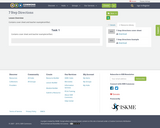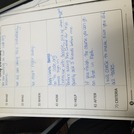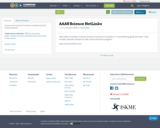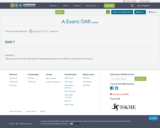
Contains cover sheet and teacher example/artifact.
- Subject:
- Elementary Education
- Material Type:
- Lesson Plan
- Author:
- Johanna Richards
- Date Added:
- 05/22/2019

Contains cover sheet and teacher example/artifact.


Lessons and tools for K-12 science teaching and after-school programs.

Welcome to the first, biannual Archival Educators Roundtable (AER) Newsletter! In 2016, the Rockefeller Archive Center (RAC) brought together like-minded professionals who use primary sources for public programming, outreach, and education, and the AER was born. As archival education is a still-developing field, the AER created a community where people could share their successes, challenges, and works in progress through casual workshops.AER’s network of educators, archivists, and archival education allies has since expanded its culture of support beyond the biannual meetings here at the RAC through social media, event attendance, joint publications, and email correspondence.It is our hope that this AER Newsletter will further extend the table, so speak, reaching more colleagues as we spotlight educators, and showcase the projects, challenges, and successes of archival education. Just as the aim of AER meetings is to ensure that all perspectives on primary source education are honored, we encourage you, our dedicated AER audience, to reach out and contribute your insights to future AER Newsletters! Many thanks to our first issue's contributors--we couldn't have done it without you.--Marissa Vassari, Archivist and Educator, Rockefeller Archive CenterElizabeth Berkowitz, Outreach Program Manager, Rockefeller Archive Center

This resource describes the plan for implementing the use of OERs in our elementary school.

Estudo de eficácia da aplicação de maquete didática, simulando o comportamento de diferentes tipos de microplásticos em distintos ambientes aquáticos, aplicado à estudantes do 7° ano de escola pública em Belém-PA.

Trata-se de um produto técnico de forma complementar a produçãointelectual da Área de Ciências Ambientais (CiAmb). O E-book tem oobjetivo de contribuir e orientar professores e gestores da educaçãobásica que pretendam aplicar a ABP associado Educação Ambiental (EA)crítica ou em qualquer outra área, fazendo as devidas adaptações àrealidade vivida. Ou seja, pode facilitar professores e gestores noentendimento da ABP e de práticas de EA crítica.

Name: ASSAM,THE LAND OF DIVERSITYDescription: The learners will learn about the state of Assam, located in the north-eastern part of India. Overview: In this content, people will learn about the state of Assam in brief. This is designed for 9th and 10th standard students as well as for aspirants of various competetive examinations. The following topics will be covered in this content.Assam - An IntroductionAssam - The PeopleAssam - The Biodiversity

The Bee Cause Project connects bees and their keepers with communities and classrooms in order to share the life-giving lessons of our humble friends, the bees. Our shared habitat is in trouble, and bees have the tools to help us make a world fit for people and pollinators. For students of all ages, a look into a hive can revolutionize their understanding of our food system while working together towards a common goal. The Bee Cause Project delivers teaching tools to communities and classrooms so long looks into a hive turn into STEM exploration, career development, and the curiosity that fuels change. Join us in building the next generation of environmental stewards!

AP4 SANGAY NG PAMAHALAAN

Expressing understanding in multiple and varied ways helps build understanding and reveal possible gaps or misconceptions. This activity supports learners to use multiple forms of expression to show data collection, data analysis, and a claim (or hypothesis) that answers a focus question.Created as part of the OASIS Coaching Support research study at CAST.

Bubbles in the bathtub is a quick, easy, and anonymous way to find out what all students are thinking. You can use this activity for predictions, reflections, brainstorming ideas for future investigations, exit tickets, and more.

Different and varied perspectives leads to richer science and better inquiry. This activity helps provide varied ways for learners to express questions, ideas, and understanding. As a result, it provides opportunities for all students, including those reticent to speak in whole-group settings, to share insights and inform class thinking.Created as part of the OASIS Coaching Support research study at CAST.

Classroom practice has shown that this "Graffiti Wall" is a highly effective strategy that encourages multiple voices, and helps ideas to spread across groups of students and classes.

Data are simply information that is gathered. Evidence is when those data are used in support of an argument or claim. This activity helps students build the cognitive link between data and using that data as evidence to support a claim.Created as part of the OASIS Coaching Support research study at CAST.

Collaborative learning is influenced by the quality of interactions, both among students and between teacher and students. Use this activity with students to co-create norms that foster a safe, welcoming, and productive environment for science inquiry learning.

Teachers consistently point out that students have difficulty differentiating opinion from data. This guided activity uses small group work and whole group conversation, guided by teachers, to build student skills in identifying the differences.Created as part of the OASIS Coaching Support research study at CAST.

Science is better when everyone contributes at least one idea. In this activity, students will practice contributing and hearing ideas from everyone in the class. Students will reflect on the impact of hearing others' ideas on their thinking as scientists.

Peer feedback is a powerful tool. Learners report their own work improved when they received feedack and, especially, when they reviewed peer work and gave targeted feedback to others.

Lesson plan and activity packet of self-affirmation activities for coaches and teachers to use with students. Created as part of the OASIS Coaching Support research study at CAST.